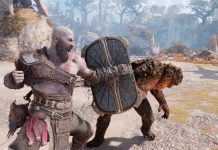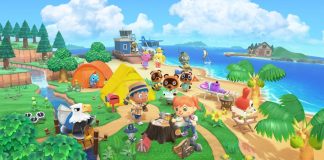LCB’s latest shows a powerful control of the things that make true pulps great.
Bears, a recent TikTok video suggested to me, are friend-coded. Why is that? Honestly, they look so cuddly. We give stuffed fabric versions of them to children and share videos of them waving as we pass by in SUVs. Speaking of SUVs, we know that, like most animals on the planet, bears are having a hard time because of us. There’s guilt there, and tenderness. And yet if we were to meet a bear in the wild, it would be – well, it would be incredibly bad news for us.
And when you meet them, what are you meant to do? Stay still? Run? Climb a tree? Are you meant to whistle, or are you only meant to whistle before you’ve met a bear, in order to preemptively scare it off?
All questions to ponder while you work your way through Grizzly Man. This is not the documentary about the guy who went to live with bears. It’s an interactive pulp fiction about a group of hikers who are menaced by a bear. Not just any bear, the Grizzly Man – half bear, half…something else. The product of CIA meddling and drug programs, sure, but also the product of millenia of humans living around bears, all that primal fear and confusion. What to do? Run? Climb a tree? Whistle?
Grizzly Man is the latest from LCB Game Studio, who may be my favourite outfit in game design at the moment. For the last few years this tiny team has been turning out pulp interactive fictions at an astonishing pace. They look like cursed early 90s PC games, with static art for the most part and a text parser which means you interact and shape the story when you can by selecting options on the screen, and occasionally tabbing through a mini-game. Fernando Martinez Ruppel does the art and Nico Saraintaris writes the story, and what you get is a series of gorgeously lurid stills that flicker past as a tale of dread and the unknown unfolds. But it’s never an empty tale of spooks and false shocks. There’s always something human being plucked away at deep inside the story, something that elevates and leaves you pondering more than just who did what and when is X going to be bludgeoned by Y.
This latest game is a case in point. It’s an astonishingly beautiful piece of craft. Ruppel’s art has so much range. The story unfolds in the wilds, and he’s a veritable Bob Ross when it comes to the mountains and the happy little trees, but the skies are always churning and toxic, and the faces – the faces are properly phenomenal. Ruppel’s got that magic where he can give every one of the characters – a surprisingly large cast this time – an instantly recognisable outline, but then the face manages to be both a caricature – it’s a type for you to lock onto and Saraintaris to then subvert – but also distinct, unique, and human. The lead here is Robert, a man with a past who’s leading a group of disparate hikers into Grizzly territory. His bald head and bright eyes seem solidly heroic at first, but you look closer and there’s a fragility there, the smooth planes of his skin seem to hint – I do not know how – that he has been taken apart and put back together and maybe the pieces do not quite fit.



The art, in other words, is a banger, even before the murders begin and the horrors start to shamble from the trees. The story, meanwhile, matches Ruppel’s lurid phantasmagoria with understatement and insular, private narrative built of memories and worst personal fears. One thing I really noticed this time is that the Pixel Pulps are truly brilliant with information – when to hold it back and when to reveal it. They will often drop in that a character knows something, or has done something, at just the right place to destabilise everything. You know how things are going to unfold and then – oops – another card lands on the table and what to do with it?

All of this, and yet Grizzly Man still manages to deliver the pulp stuff: a monster in the woods, who is, themselves, a sign of greater, more vaporous monstrousness. A cast who you’re fascinated by just as they start to individually run into trouble. A lead who is… well, best leave that for you. Early threads that are left dangling and which tie up at the perfect moment. And even what Hitchcock called The Icebox Moment: you go to see the film, you walk home and discuss it with your friend and make sense of the plot, and then at 3 in the morning you get up and go for a drink from the fridge and think – wait a minute, what did that part mean?
LCB has just come to the end of its first trilogy of pulps, and Grizzly Man marks the beginning of Season Two, as it were. All I’m missing is a pal who’s playing along with me, so I can discuss the course of things as if we’re picking over a great TV series. But this is a TV series with the eye of a painter and the soul of a novelist, and each one chucks in a great Solitaire variant – Grizzly Man’s is an absolute killer – and plenty of weird ludic asides. Grizzly Man is a treat, anyway. I can’t wait to see what comes next.
A copy of Grizzly Man was independently bought by the author.


































